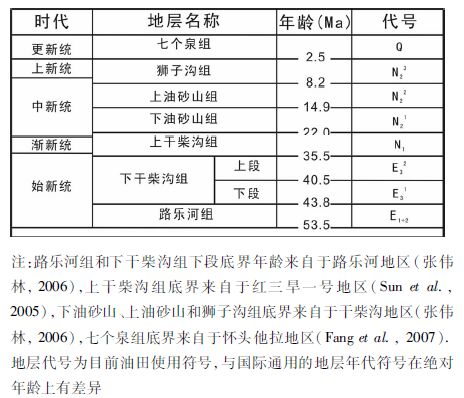2. 教育部含油气盆地构造研究中心,杭州 310027;
3. 浙江省第三地质大队,金华 322100;
4. 东方地球物理公司研究院,涿州 072751
2. Research Center for Structures in Oil & Gas Bearing Basins, Ministry of Education,Hangzhou 310027, China;
3. Zhejiang No.3 Geology Group, Jinhua 322100,China;
4. Research Institute of BGP inc., China National Petroleum Corporation, Zhuozhou 072751, China
阿尔金断裂作为青藏高原北部最重要的走滑断裂之一(Molnar and Tapponnier, 1975),它的走滑运动吸收了印度-亚洲板块碰撞造成的大量位移(Tapponnier et al., 2001)。阿尔金断裂的开始活动时间一直是地质学家们关注的问题,因为其对理解青藏高原的形成过程有着至关重要的作用,目前的研究分别有认为其形成于前中生代(周勇和潘裕生, 1999;刘良等, 2009;伍跃中等, 2007)、中生代(李海兵等, 2006)以及新生代(Wu et al., 2012a, b ;Yin et al., 2002),可见是一个非常具有争议性的问题。柴达木盆地西北缘与阿尔金断裂直接接触,并且发育了完整的新生代地层(图 1),因此是研究阿尔金断裂发育演化的理想场所。本文试图通过柴达木盆地西北缘的沉积、构造研究结果,对阿尔金断裂最初活动时间以及活动方式进行初步限定。
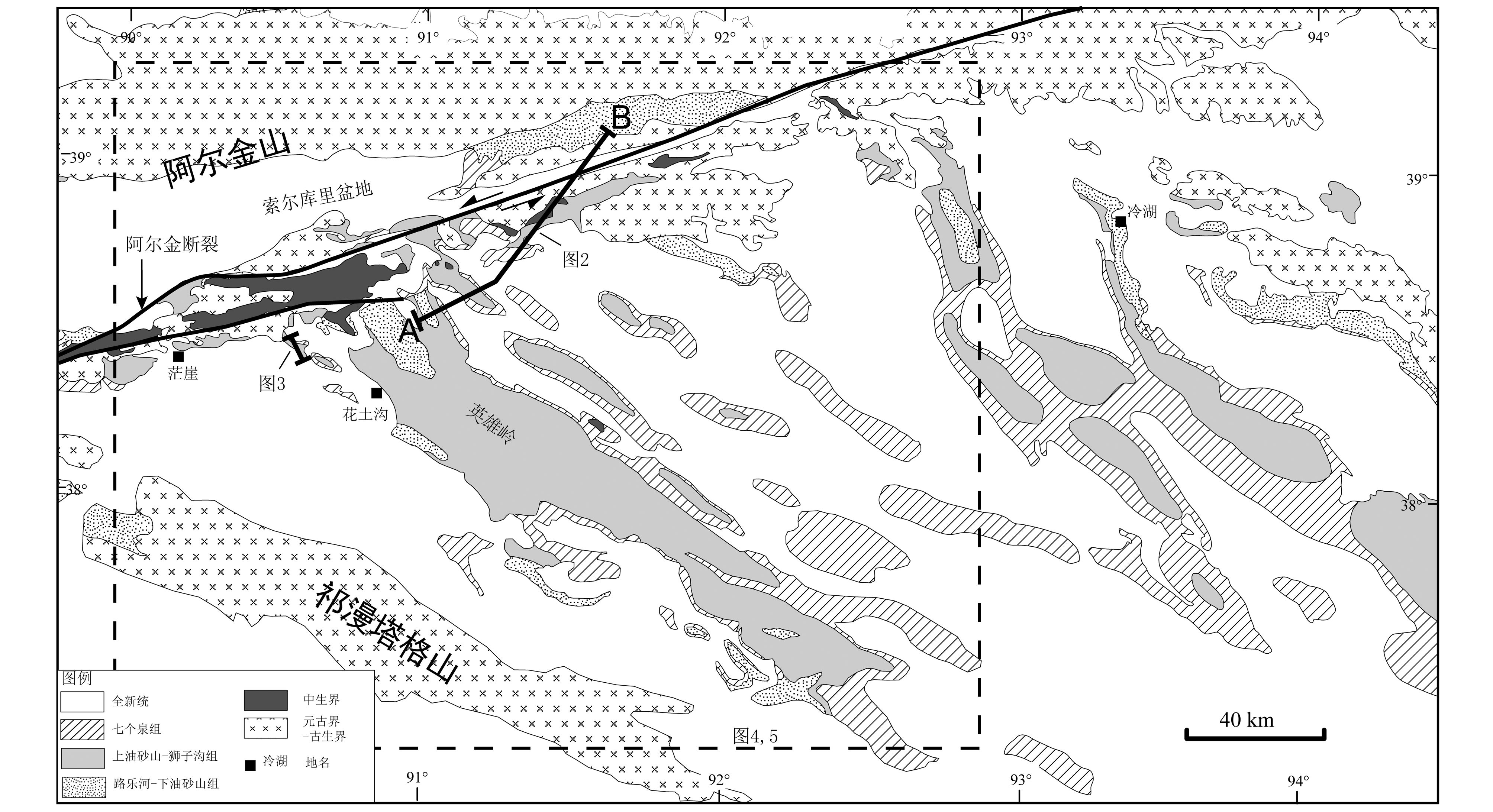
|
图 1 柴达木盆地西部地区简要地质图(据吴磊, 2011修改) 图 2~图 5的位置见本图 Fig. 1 Simplified geological map of western Qaidam Basin (modified after Wu, 2011) Locations of Fig. 2~Fig. 5 are shown in this figure |
柴达木盆地位于青藏高原东北部,被昆仑山、阿尔金山和祁连山等大型山脉所包夹。中生代以来是个陆相盆地,三叠纪缺失地层记录。侏罗纪的盆地原型尚有争论,有认为柴达木盆地在侏罗纪时是南祁连山的前陆盆地,在晚侏罗世构造活动增强(Ritts and Ulderico, 2001),也有研究认为柴达木盆地在早、中侏罗世是断陷盆地,并在晚侏罗开始发生反转(Wang et al., 2007; Wu et al., 2011)。早些年研究认为新生代柴达木盆地是一个前陆盆地(Chen et al., 1999; Zhu et al., 2006)或者早期拉张断陷,后期挤压反转的陆内盆地(Xia et al., 2001)。但是最近的研究表明,柴达木盆地的沉积中心一直都大致处在盆地的中轴线上(Meng and Fang, 2008;Yin et al., 2008),其新生代以来的沉积特征不符合前陆或者断陷盆地的典型样式,因此柴达木盆地的成盆动力机制有待进一步研究。目前主要有学者认为柴达木盆地可能是新生代以来受到印藏碰撞而形成的一个挠曲盆地(Meng and Fang, 2008)或者是由于东昆仑山和祁连山下部的楔形构造体向盆地方向刺入而形成的背驮盆地(Yin et al., 2008)以及由软弱下地壳流动,在盆地边缘聚集而导致盆地挤压沉降形成的坳陷湖盆(Clark and Royden, 2000)。
柴达木盆地新生代主要是陆相湖泊沉积,在盆地周缘发育有冲积扇等边缘相沉积体。新生代地层目前划分为8个地层单元(表 1),并且已经有较好的磁性地层年龄进行约束(Fang et al., 2007;Sun et al., 2005;杨藩等, 1992;张伟林, 2006),自下到上分别是路乐河组(53.5~43.8Ma)、下干柴沟组下段(43.8~40.5Ma)、下干柴沟组上段(40.5~35.5Ma)、上干柴沟组(35.5~22.0Ma)、下油砂山组(22.0~14.9Ma)、上油砂山组(14.9~8.2Ma)、狮子沟组(8.2~2.5Ma)和七个泉组(2.5Ma~现今)。
|
|
表 1 柴达木盆地新生代地层表 Table 1 Cenozoic stratigraphic chart of Qaidam Basin |
柴达木盆地西北缘紧邻阿尔金断裂,通过盆地西北缘的沉积记录,来研究阿尔金断裂的形成演化,不失为一种可行和可信的思路。我们利用地震剖面制作了NE走向,切过柴达木西北缘斜交阿尔金断裂的一条区域性构造剖面(图 2)。阿尔金断裂在剖面上表现为正花状构造,在柴达木西北缘形成一个大型的隆起,自盆地往山的方向依次剥露中生界、古生界和结晶基底,而新生代地层主要分布在盆地内部。柴达木盆地新生代地层中路乐河组和下干柴沟组下段在剖面上分布厚度较为均一,见不到向阿尔金山方向减薄的趋势,说明这个时期柴达木西北缘的沉积地层发育尚未受到阿尔金的影响。但是自下干柴沟组上段(E32)开始,地层向阿尔金断裂的方向减薄尖灭,我们认为这种地层减薄现象是由阿尔金断裂活动所导致。局部更加详细的地震剖面(图 3)也表明柴达木盆地西北缘自下干柴沟组上段(E32)开始出现生长地层,在下油砂山组(N21)开始出现向阿尔金山前强烈尖灭减薄。上油砂山组则是角度不整合的盖在下伏地层之上(王亮等, 2010)。

|
图 2 咸水泉-阿尔金断裂构造大剖面 地层代号:①元古界-中生界;②路乐河组;③下干柴沟组下段;④下干柴沟上段;⑤上干柴沟组;⑥下油砂山组;⑦上油砂山组;⑧狮子沟组;⑨七个泉组 Fig. 2 Structural profile from the Xianshuiquan to the Altyn Fault Code number: ①Proterozoic-Mesozoic rocks; ②Lulehe Fm.; ③Lower Xiaganchaigou Fm.; ④Upper Xiaganchaigou Fm.; ⑤Shangganchaigou Fm.; ⑥Lower Youshashan Fm.; ⑦Upper Youshashan Fm.; ⑧Shizigou Fm.; ⑨Qigequan Fm. |
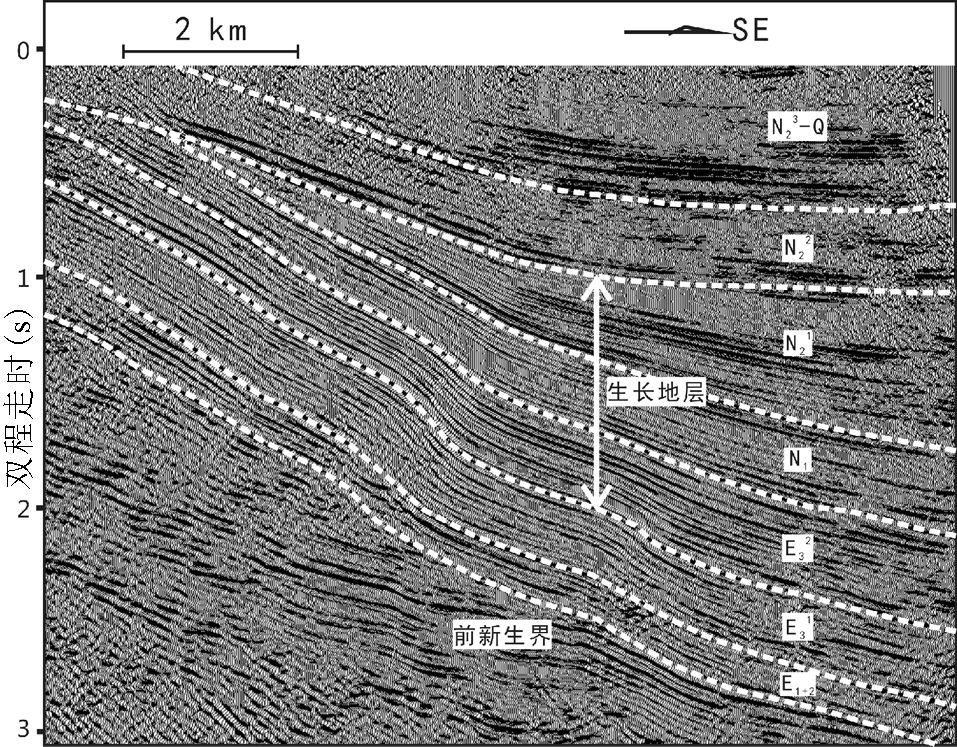
|
图 3 柴达木盆地西北缘地层接触关系 地层代号参考表 1 Fig. 3 Strata relationship of NW Qaidam Basin Symbols are same as those in Table 1 |
由上小节分析可知柴达木盆地西北缘下干柴沟组上段(E32)开始出现向阿尔金山方向减薄的生长地层,因此我们选取了这两个关键时期柴达木盆地西部的地层残余厚度图和沉积相图,对古隆起在平面上的分布特征进行刻画。
下干柴沟组上段的残余厚度(图 4)表明现存的地层在柴达木盆地西部有两个较深的凹陷,凹陷中心的地层厚度大于2000m,并且在紧挨阿尔金山一侧有两个斜列式排列NWW走向的古隆起,其现存的宽度可达~10km,地层厚度自凹陷向古隆起依次减薄。上干柴沟组残余厚度图(图 5)同样反映现存地层存在两个主要的凹陷,但是凹陷中心的地层厚度有所减薄,为1500m左右。阿尔金山前的古隆起形态继承了E32时期的特征,在分布特征,形态以及规模上都没有明显变化。
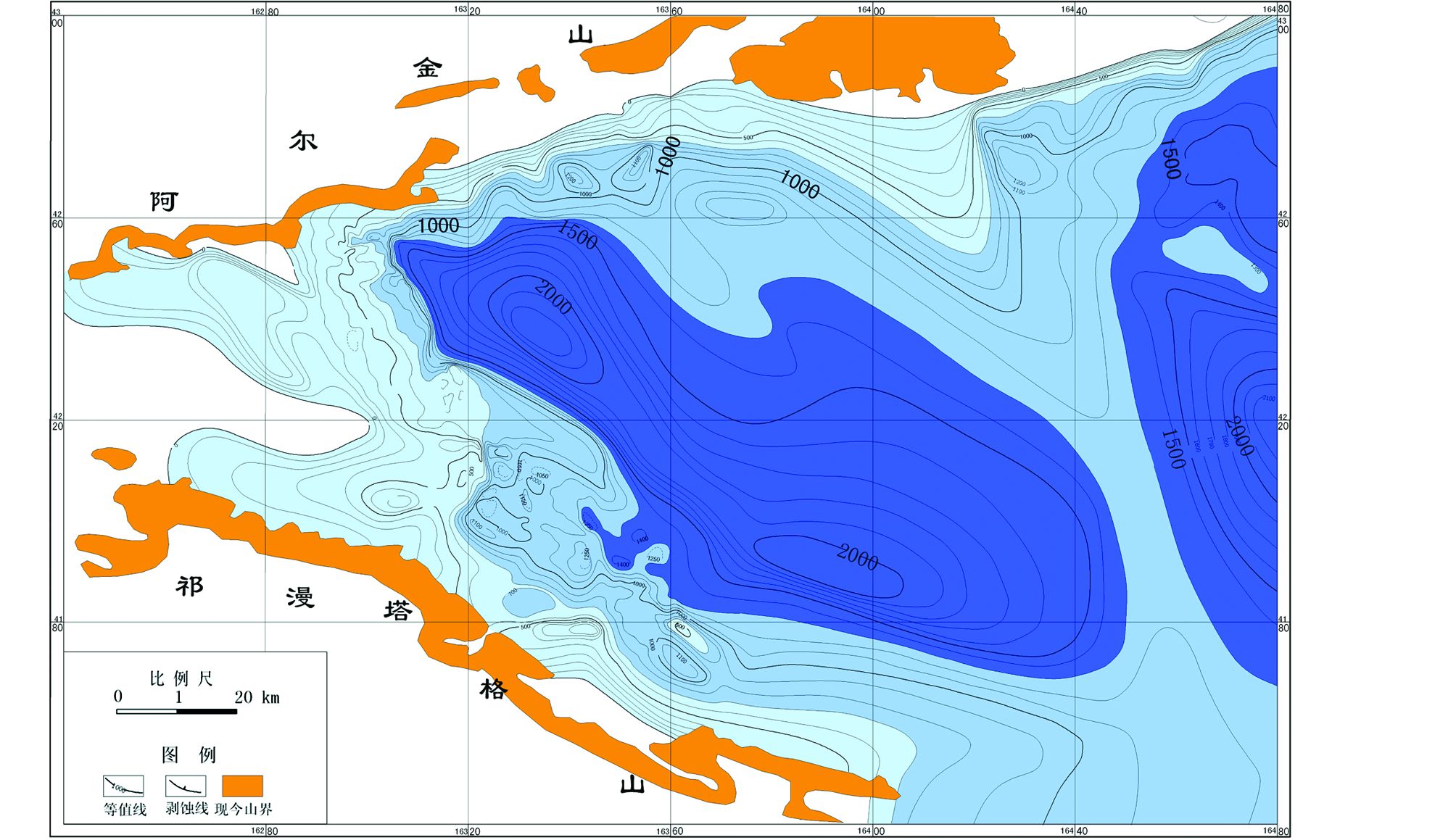
|
图 4 柴达木盆地西部地区下干柴沟组上段地层残余厚度图 Fig. 4 Residual strata isopach map of Upper Xiaganchaigou Fm. of western Qaidam Basin |
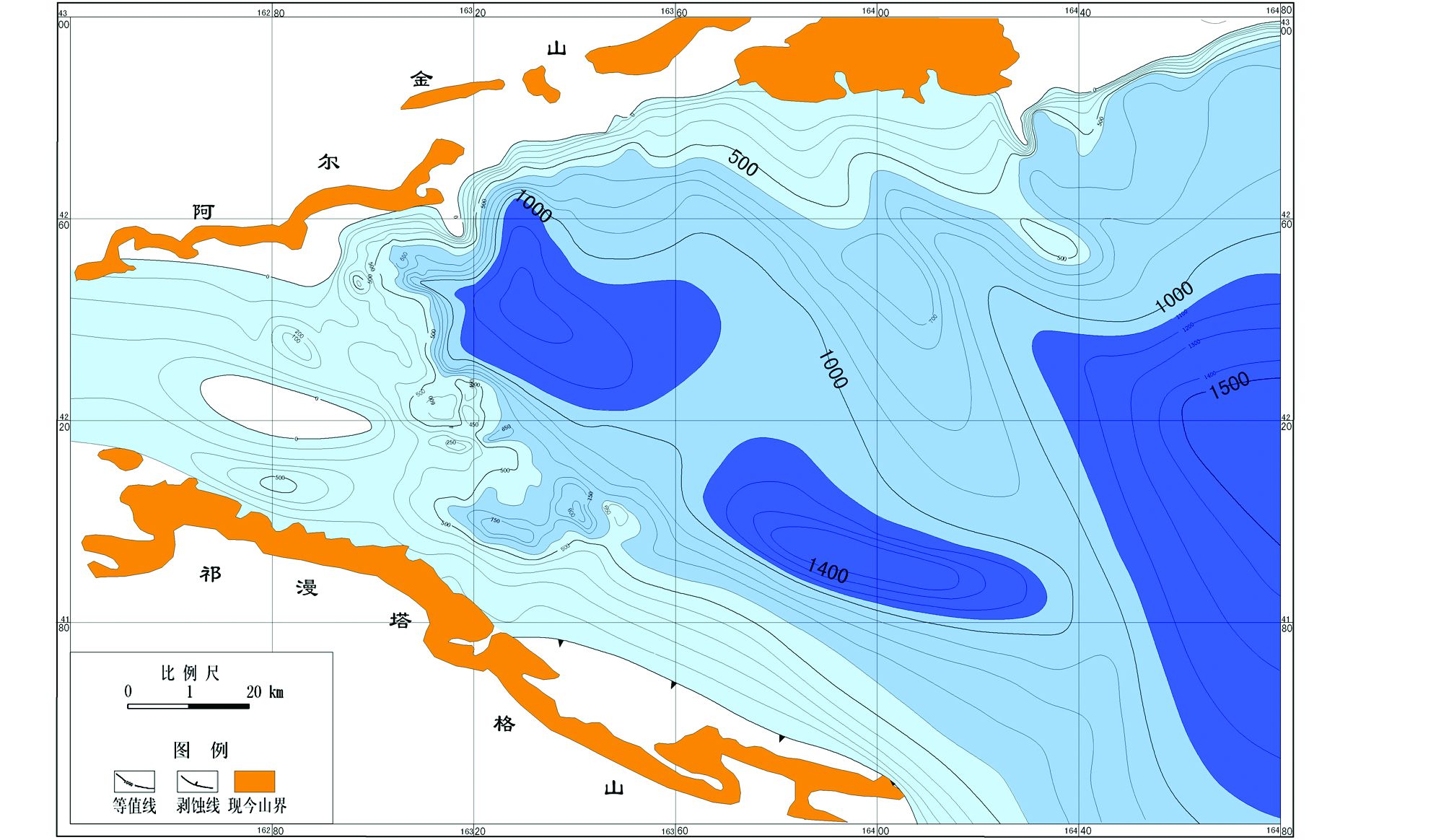
|
图 5 柴达木盆地西部地区上干柴沟组地层残余厚度图 Fig. 5 Residual strata isopach map of Shangganchaigou Fm. of western Qaidam Basin |
柴达木盆地西部地区在下干柴沟组下段(E32)沉积相(图 6)主要有半深湖-深胡,浅胡,滨湖,河流泛滥平原扇三角洲以及冲积扇相。其中湖相沉积物的分布范围和残余厚度图上地层较厚的沉积凹陷有着很好的对应关系,即在盆地西部主要也发育两个较深的次级湖盆。厚度图展示的阿尔金山前的古隆起在沉积相图对应位置是扇三角洲相沉积,其规模和分布特征都与厚度图上展示的古隆起比较一致。上干柴沟组(N1)的沉积相(图 7)特征大体继承了E32时期的特征。
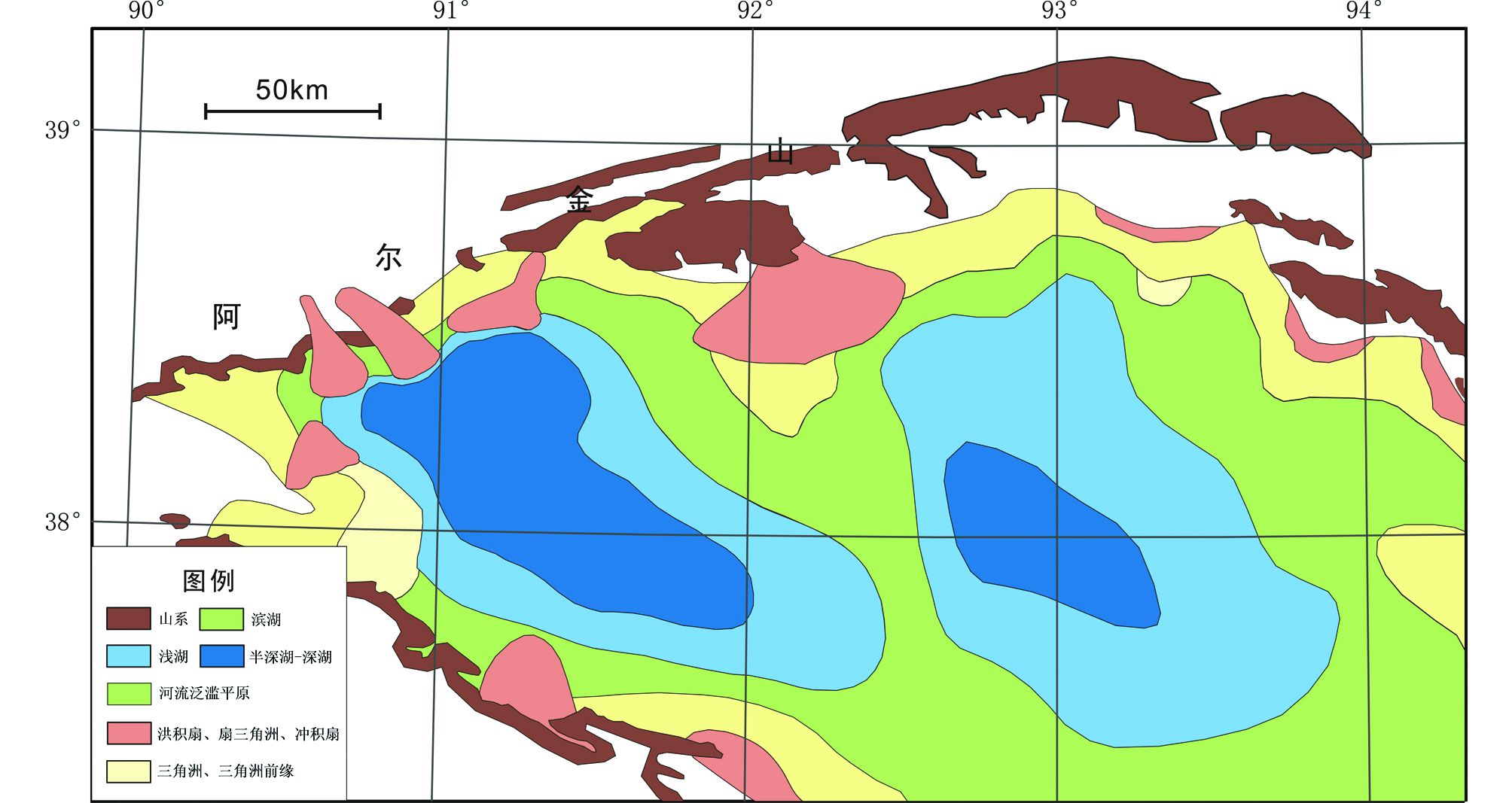
|
图 6 柴达木盆地西部地区下干柴沟组上段沉积相图 Fig. 6 Sedimentary facies of Upper Xiaganchaigou Fm. in western Qaidam Basin |
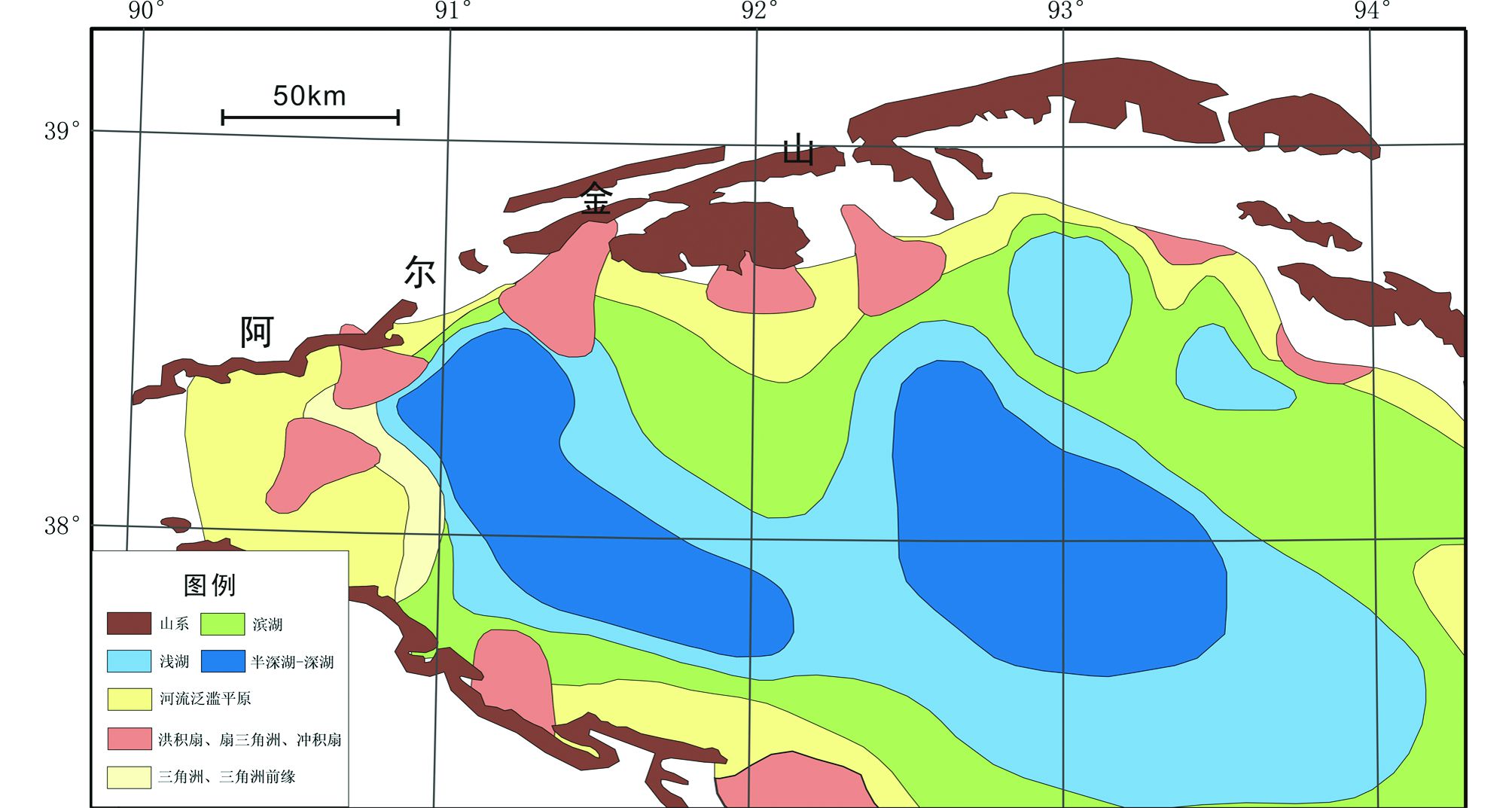
|
图 7 柴达木盆地西部地区上干柴沟组沉积相图 Fig. 7 Sedimentary facies of Upper Xiaganchaigou Fm. in western Qaidam Basin |
区域地震剖面反映出自下干柴沟组上段开始,地层向阿尔金山方向减薄,而更加精细的地震剖面则反映出下干柴沟组上段地层开始出现生长地层,下油砂山组开始出现大量的上超现象,因此可以初步判断古隆起形成于下干柴沟组上段沉积之时。沉积厚度和沉积相分析亦表明在下干柴沟上段沉积时,柴达木西北缘已经形成古隆起,其形态为与阿尔金断裂呈约30°相交的半椭圆形,对应沉积环境为河流或者冲积扇。综合上述分析,我们认为阿尔金断裂活动导致的隆升作用在下干柴沟组上段沉积时期(始新世晚期)就已经出现。
5.2 古隆起的形成与阿尔金断裂的关系走滑断裂在开始活动的阶段在地表会形成雁列式的褶皱来进行调节位移量(Jamison, 1991;Tikoff and Peterson, 1998),这种调节褶皱与深部主控的走滑断层之间的夹角介于0°和45°之间,具体视正向挤压分量和走滑分量比例而定,如在单纯挤压的情况下为0°而单纯走滑的情况下则为45°(Titus et al., 2007)。位于柴达木盆地西北缘的古隆起形成于阿尔金断裂活动引起的地表抬升。通过地层残余厚度图判断,它们大致为E-W或者NWW-SEE走向,与阿尔金断裂以~30°的角度相交,符合在压扭环境中的构造样式(Titus et al., 2007)。因此我们认为阿尔金断裂在始新世晚期开始初步发育,此时在深部可能是以韧性剪切带的方式出现,在地表则并没有直接出现走滑断裂,而是以发育雁列式褶皱和断裂的方式来调节深部的走滑位移量(图 8)。这种雁列式褶皱在柴达木盆地西北缘以较薄的沉积厚度和粗粒的沉积相等信息所记录,并且被阿尔金断裂后来的强烈走滑作用所改造。
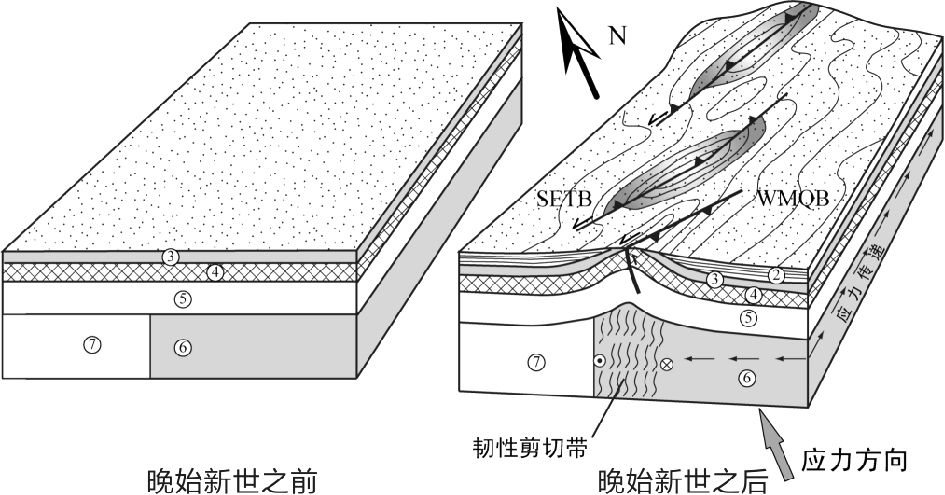
|
图 8 阿尔金断裂初始活动阶段构造模型(据吴磊, 2011修改) SETB-塔东南;WMQB-柴达木盆地西缘;②晚始新世-中中新世间沉积地层;③中生界和新生代早期(晚始新世之前)沉积地层;④古生代地层和元古界基底;⑤上地壳;⑥青藏高原中下地壳;⑦塔里木盆地中下地壳 Fig. 8 Tectonic model of the initial movement of the Altyn Fault (modified after Wu, 2011) SETB-SE Tarim Basin; WMQB-western margin of Qaidam Basin; ②rocks of Late Eocene-Middle Miocene; ③Mesozoic and Early Cenozoic (prior to the Late Eocene) rocks; ④Proterozoic basement and Paleozoicrocks; ⑥middle to lower crust of Tibet Plateau; ⑦middle to lower crust of Tarim Basin |
本文通过分析柴达木西北缘的地震剖面,残余厚度图和沉积相图后得出以下结论:
(1) 柴达木盆地西北缘在下干柴沟组上段开始发生抬升,形成向阿尔金山方向减薄的生长地层,并一直延续到下油砂山组沉积结束。
(2) 柴达木盆地西北缘在平面上存在两个与阿尔金断裂以~30°相交的残余古隆起,该古隆起形成于下干柴沟组上段沉积之时(始新世晚期),古隆起表现为较薄的地层厚度以及较粗的沉积物,如大多为冲积扇或河流等边缘沉积相,而非隆起地区则为湖相沉积。
(3) 本文分析认为阿尔金断裂在始新世晚期开始孕育,在深部形成左旋韧性剪切带,在地表则通过形成左阶雁列式褶皱进行调节左旋位移量。
| [] | Chen WP, Chen CY, Belek J. 1999. Present-day deformation of the Qaidam basin with implications for intra-continental tectonics. Tectonophysics, 305(1-3): 165–181. DOI:10.1016/S0040-1951(99)00006-2 |
| [] | Clark MK, Royden LH. 2000. Topographic ooze: Building the eastern margin of Tibet by lower crustal flow. Geology, 28(8): 703. DOI:10.1130/0091-7613(2000)28<703:TOBTEM>2.0.CO;2 |
| [] | Fang XM, Zhang WL, Meng QQ, Gao JP, Wang XM, King J, Song CH, Dai S, Miao YF. 2007. High-resolution magnetostratigraphy of the Neogene Huaitoutala section in the eastern Qaidam Basin on the NE Tibetan Plateau, Qinghai Province, China and its implication on tectonic uplift of the NE Tibetan Plateau. Earth and Planetary Science Letters, 258(1-2): 293–306. DOI:10.1016/j.epsl.2007.03.042 |
| [] | Jamison WR. 1991. Kinematics of compressional fold development in convergent wrench terrances. Tectonophysics, 190(2-4): 209–232. DOI:10.1016/0040-1951(91)90431-Q |
| [] | Li HB, Yang JS, Xu ZQ, Sun ZM, Tapponnier P, van der Woerd J, Meriaux AS. 2006. The constraint of the Altyn Tagh fault system to the growth and rise of the northern Tibetan plateau. Earth Science Frontiers, 13(4): 59–79. |
| [] | Liu L, Chen DL, Wang C, Zhang CL. 2009. New progress on geochronology of high-pressure / ultrahigh-pressure metamorphic rocks from the South Altyn Tagh, the North Qaidam and the North Qinling orogenic, NW China and their geological significance. Journal of Northwest University (Natural Science Edition), 39(3): 472–479. |
| [] | Meng QR, Fang X. 2008. Cenozoic tectonic development of the Qaidam Basin in the northeastern Tibetan Plateau. Geological Society of America Special Papers, 444: 1–24. |
| [] | Molnar P, Tapponnier P. 1975. Cenozoic tectonics of Asia: Effects of a continental collision. Science, 189(4201): 419–426. DOI:10.1126/science.189.4201.419 |
| [] | Ritts BD, Ulderico B. 2001. Mesozoic northeast Qaidam basin: Response to contractional reactivation of the Qilian Shan, and implications for the extent of Mesozoic intracontinental deformation in central Asia. Geological Society of America Bulletin, 194: 293–316. |
| [] | Sun ZM, Yang ZY, Pei JL, Ge XH, Wang XS, Yang TS, Li WM, Yuan SH. 2005. Magnetostratigraphy of Paleogene sediments from northern Qaidam Basin, China: Implications for tectonic uplift and block rotation in northern Tibetan Plateau. Earth and Planetary Science Letters, 237(3-4): 635–646. DOI:10.1016/j.epsl.2005.07.007 |
| [] | Tapponnier P, Xu ZQ, Roger F, Meyer B, Arnaud N, Wittlinger G, Yang JS. 2001. Oblique stepwise rise and growth of the Tibet Plateau. Science, 294(5547): 1671–1677. DOI:10.1126/science.105978 |
| [] | Tikoff B, Peterson K. 1998. Physical experiments of transpressional folding. Journal of Structural Geology, 20(6): 661–672. DOI:10.1016/S0191-8141(98)00004-2 |
| [] | Titus SJ, Housen B, Tikoff B. 2007. A kinematic model for the Rinconada fault system in central California based on structural analysis of en echelon folds and paleomagnetism. Journal of Structural Geology, 29(6): 961–982. DOI:10.1016/j.jsg.2007.02.004 |
| [] | Wang J, Ni J, Liu P. 2007. Control of the early faulted depression of superimposed basins on uplift belts and depression belts: A new explanation for the origin of uplift belts and depression belts in the northern Qaidam Basin. Journal of Guilin University of Technology, 27(3): 299–303. |
| [] | Wang L, Xiao AC, Gong QL, Liu D, Shen ZY, Zhou SP, Wu L, Lou QQ, Sun XW. 2010. The unconformity in Miocene sequence of western Qaidam Basin and its tectonic significance. Scientia Sinica (Terrae), 40(11): 1582–1590. |
| [] | Wu L. 2011. The Cenozoic tectonic process of central segment of the Altyn Tagh Fault and its basin response. Ph. D. Dissertation. Hangzhou: Zhejiang University (in Chinese with English summary) |
| [] | Wu L, Xiao AC, Wang LQ, Shen ZY, Zhou SP, Chen YZ, Wang L, Liu D, Guan JY. 2011. Late Jurassic-Early Cretaceous northern Qaidam Basin, NW China: Implications for the earliest Cretaceous intracontinental tectonism. Cretaceous Research, 32(4): 552–564. DOI:10.1016/j.cretres.2011.04.002 |
| [] | Wu L, Xiao AC, Wang LQ, Mao LG, Wang L, Dong YP, Xu B. 2012a. EW-trending uplifts along the southern side of the central segment of the Altyn Tagh Fault, NW China: Insight into the rising mechanism of the Altyn Mountain during the Cenozoic. Science China (Earth Sciences), 55(6): 926–939. DOI:10.1007/s11430-012-4402-7 |
| [] | Wu L, Xiao AC, Yang SF, Wang LQ, Mao LG, Wang L, Dong YP, Xu B. 2012b. Two-stage evolution of the Altyn Tagh Fault during the Cenozoic: New insight from provenance analysis of a geological section in NW Qaidam Basin, NW China. Terra Nova, 24(5): 387–395. DOI:10.1111/ter.2012.24.issue-5 |
| [] | Wu YZ, Li RS, Wang Z, Lei XW, Zhang Z, Xie CR. 2007. The attribution of Altyn marginal faults. Earth Science, 32(5): 662–670. |
| [] | Xia WC, Zhang N, Yuan X, Fan LS, Zhang BS. 2001. Cenozoic Qaidam Basin, China: A stronger tectonic inversed, extensional rifted basin. AAPG Bulletin, 85(4): 715–736. |
| [] | Yang F, Ma Z, Xu T, Ye S. 1992. A Tertiary paleomagnetic stratigraphic profile in Qaidam basin. Acta Petrologica Sinica, 13(2): 97–101. |
| [] | Yin A, Rumelhart PE, Butler R, Cowgill E, Harrison TM, Foster DA, Ingersoll RV, Qing Z, Xian QZ, Xiao FW. 2002. Tectonic history of the Altyn Tagh Fault system in northern Tibet inferred from Cenozoic sedimentation. Geological Society of America Bulletin, 114(10): 1257–1295. DOI:10.1130/0016-7606(2002)114<1257:THOTAT>2.0.CO;2 |
| [] | Yin A, Dang YQ, Zhang M, Chen XH, Mcrivette MW. 2008. Cenozoic tectonic evolution of the Qaidam Basin and its surrounding regions (Part 3): Structural geology, sedimentation, and regional tectonic reconstruction. Geological Society of America Bulletin, 120(7-8): 847–876. DOI:10.1130/B26232.1 |
| [] | Zhang WL. 2006. High-resolution megnetostratigraphy of the Cenozoic Qaidam Basin, implications for the uplift of Tibetan Plateau. Ph. D. Dissertation. Lanzhou: Lanzhou University (in Chinese with English summary) |
| [] | Zhou Y, Pan YS. 1999. The initial shear sense of the Allun Fault and its timing. Geological Review, 45(1): 1–9. |
| [] | Zhu L, Wang C, Zheng H, Xiang F, Yi H, Liu D. 2006. Tectonic and sedimentary evolution of basins in the northeast of Qinghai-Tibet Plateau and their implication for the northward growth of the plateau. Palaeogeography, Palaeoclimatology, Palaeoecology, 241(1): 49–60. |
| [] | 李海兵, 杨经绥, 许志琴, 孙知明, TapponnierP, vander Woerd J, MeriauxAS. 2006. 阿尔金断裂带对青藏高原北部生长, 隆升的制约. 地学前缘, 13(4): 59–79. |
| [] | 刘良, 陈丹玲, 王超, 张成立. 2009. 阿尔金, 柴北缘与北秦岭高压-超高压岩石年代学研究进展及其构造地质意义. 西北大学学报(自然科学版), 39(3): 472–479. |
| [] | 王亮, 肖安成, 巩庆霖, 刘东, 沈中延, 周苏平, 吴磊, 楼谦谦, 孙晓文. 2010. 柴达木盆地西部中新统内部的角度不整合及其大地构造意义. 中国科学(地球科学), 40(11): 1582–1590. |
| [] | 吴磊. 2011. 阿尔金断裂中段新生代活动过程及盆地响应. 博士学位论文. 杭州: 浙江大学 |
| [] | 伍跃中, 李荣社, 王战, 雷学武, 张转, 谢丛瑞. 2007. 阿尔金山各边界断裂的归属性. 地球科学, 32(5): 662–670. |
| [] | 杨藩, 马志强, 许同春, 叶素娟. 1992. 柴达木盆地第三纪磁性地层柱. 石油学报, 13(2): 97–101. |
| [] | 张伟林. 2006. 柴达木盆地新生代高精度磁性地层与青藏高原隆升. 博士学位论文. 兰州: 兰州大学 |
| [] | 周勇, 潘裕生. 1999. 阿尔金断裂早期走滑运动方向及其活动时间探讨. 地质论评, 45(1): 1–9. |
 2013, Vol. 29
2013, Vol. 29



